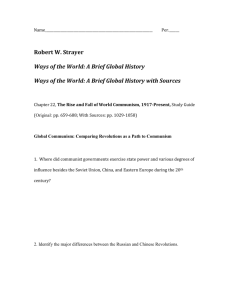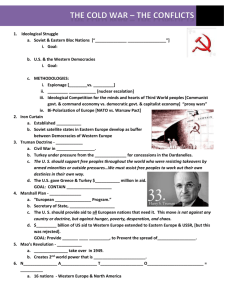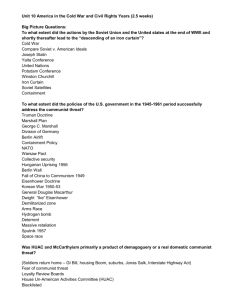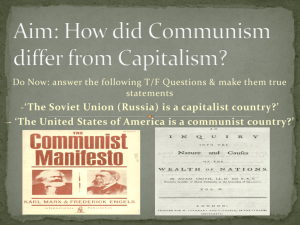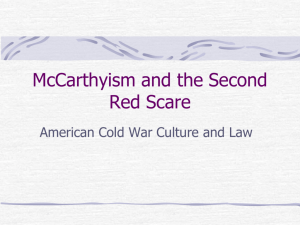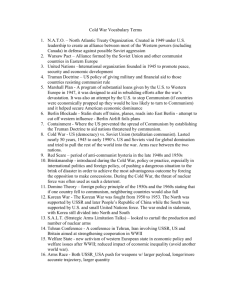CH. 15 The Cold War Begins Study Guide
advertisement
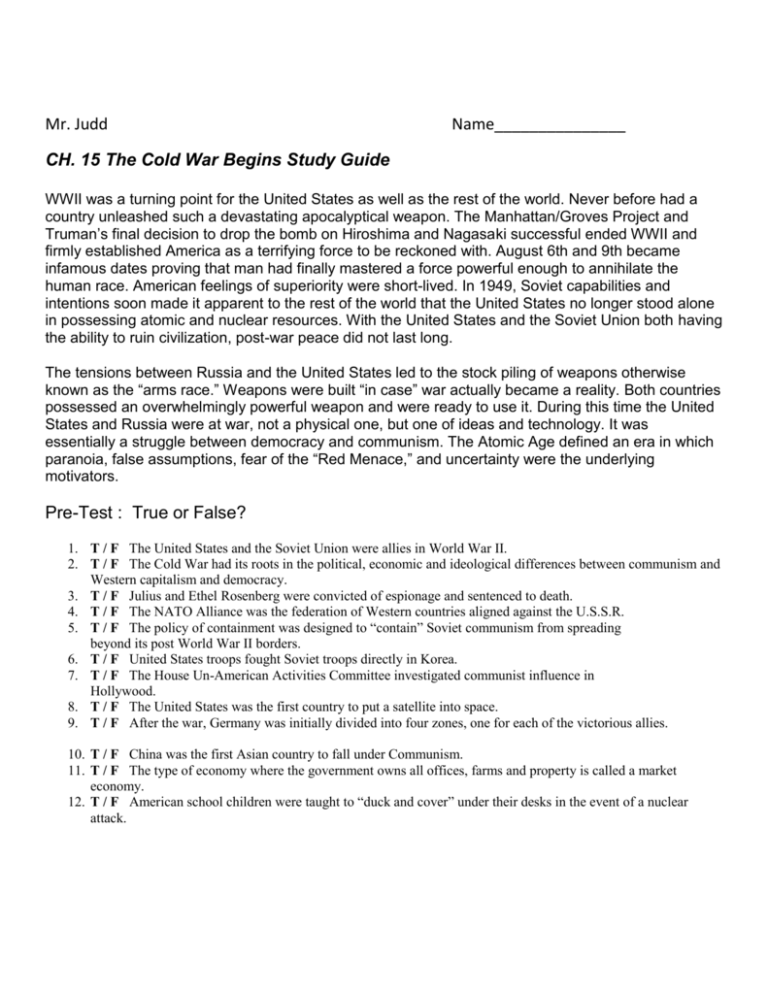
Mr. Judd Name_______________ CH. 15 The Cold War Begins Study Guide WWII was a turning point for the United States as well as the rest of the world. Never before had a country unleashed such a devastating apocalyptical weapon. The Manhattan/Groves Project and Truman’s final decision to drop the bomb on Hiroshima and Nagasaki successful ended WWII and firmly established America as a terrifying force to be reckoned with. August 6th and 9th became infamous dates proving that man had finally mastered a force powerful enough to annihilate the human race. American feelings of superiority were short-lived. In 1949, Soviet capabilities and intentions soon made it apparent to the rest of the world that the United States no longer stood alone in possessing atomic and nuclear resources. With the United States and the Soviet Union both having the ability to ruin civilization, post-war peace did not last long. The tensions between Russia and the United States led to the stock piling of weapons otherwise known as the “arms race.” Weapons were built “in case” war actually became a reality. Both countries possessed an overwhelmingly powerful weapon and were ready to use it. During this time the United States and Russia were at war, not a physical one, but one of ideas and technology. It was essentially a struggle between democracy and communism. The Atomic Age defined an era in which paranoia, false assumptions, fear of the “Red Menace,” and uncertainty were the underlying motivators. Pre-Test : True or False? 1. T / F The United States and the Soviet Union were allies in World War II. 2. T / F The Cold War had its roots in the political, economic and ideological differences between communism and Western capitalism and democracy. 3. T / F Julius and Ethel Rosenberg were convicted of espionage and sentenced to death. 4. T / F The NATO Alliance was the federation of Western countries aligned against the U.S.S.R. 5. T / F The policy of containment was designed to “contain” Soviet communism from spreading beyond its post World War II borders. 6. T / F United States troops fought Soviet troops directly in Korea. 7. T / F The House Un-American Activities Committee investigated communist influence in Hollywood. 8. T / F The United States was the first country to put a satellite into space. 9. T / F After the war, Germany was initially divided into four zones, one for each of the victorious allies. 10. T / F China was the first Asian country to fall under Communism. 11. T / F The type of economy where the government owns all offices, farms and property is called a market economy. 12. T / F American school children were taught to “duck and cover” under their desks in the event of a nuclear attack. UNDERSTANDING MARKETS Mr. Judd How are economies organized? Vocabulary: economics economy command economy market economy mixed economy You have read about buying and selling. You have also read about how a business works. The study of how a society makes and sells goods and services is called economics. Each country has its own way to decide how things are made and who gets them. This is called the country’s economy. There are different kinds of economies. In a market economy, the buyers and sellers decide what they want to make and buy. The buyer decides how to spend his or her money. The seller decides what to make based on what people want to buy. The government does not tell people what to buy and sell. In a command economy, the government makes most of the decisions. It tells people what and how much to make. It tells them where to sell their goods. For example, the government might tell a farmer to plant corn. After the corn is harvested, the government tells the farmer who can buy the corn and how much they will pay. North Korea is an example of a command economy. A mixed economy is a combination of both kinds of economies. Both the market and the government help determine what people buy and sell. However, in a mixed economy, the market is usually stronger. The government does not tell people what to buy or sell, but it makes rules that shape the economy. In addition, the government can influence the economy by what the government buys and sells. For example, when farmers in the United States grow more wheat than they can sell, the government often buys extra wheat. This helps keep the price high enough so farmers don’t lose money. In a mixed economy, governments also often own parts of the economy, such as power and transportation companies. Most countries have mixed economies, including the United States. In the United States, people are free to choose what to buy and sell. However, the government makes rules about issues like workplace safety, product safety, and what workers can be paid. It also spends so much money, that its spending affects the market. CATEGORIZING MARKETS Mr. Judd Read each paragraph. Decide if it describes a market, command, or mixed economy. Write the letter of your choice in the Venn Diagram. A. Wayne is a fisherman. The government tells him where he can fish. Wayne decides how much fish to catch. B. Ed works on a farm. The government tells him to plant soybeans. The government tells him what price to charge for his beans. C. Gerre makes cheese. She decides to make cheddar cheese. The government buys her cheese. D. Mike has a pet-sitting business. He decides how many pets to sit. He decides what price to charge. E. Matilde cuts hair. The government tells her what hours she can work. The government tells her how much she can charge to cut hair. F. Keisha owns an ice cream stand. She decides how much ice cream to sell. She decides what price to charge for her ice cream. Market Economy Mixed Economy Command Economy The Ideal Communist State Mr. Judd Communism is a system of government based on the ideas of Karl Marx (a German political thinker writing in the mid-nineteenth century). The aim of communism is to get rid of inequality between different classes in society. It is based on the idea of sharing goods, labor and services so that everyone has exactly what he or she requires, but no one accumulates wealth for the sake of reputation or prestige. In a purely communist society, money would not be necessary; instead a system of bartering would exist in which people exchanged the things they produced with other people. And because each person would only get what they needed and no more, there would be enough for everyone. Such a system would, however, be very complicated to organize. Marx therefore thought it would be necessary for a strong communist government to organize the establishment of communism. The government would take over ownership of all factories, banks, businesses and properties. It would then allocate flats to workers, provide employment and ensure free health and education services. This would help to break down the divisions between the different classes. The government (which would be controlled by the Communist Party) would act in the best interests of the people, so there would be no need for any other political parties and therefore no need for democratic elections. Similarly, given that the Communist Party represented the best interests of the people, any criticism of the party in the press would not be tolerated. According to Marx, government by the Communist Party would only be temporary, for once society was running according to communist principles and each person was sharing goods and living in harmony, the government would no longer be needed and so would simply cease to exist. Only then would a state of pure communism exist. Communists believed that it was the duty of a communist country to try to spread communism to other countries by stirring up communist revolutions abroad. The communist slogan was ‘workers of the world unite!’ Communism in the USSR When Russia became a communist state in 1917 following a revolution led by the Communist Party, things did not quite turn out as Marx had planned. The Russian Communist Party abolished all other political parties and set up a dictatorship, but by 1945 they showed no signs of giving up power. The members of the Communist Party were given special privileges and lived in larger houses, ate more luxurious food and wore more expensive clothes than the rest of the population. Opponents of the Communist Party were persecuted. This was especially true in the 1930s when the paranoia of the communist leader, Josef Stalin, led him to accuse even innocent people of opposing the communists. Consequently millions of Russians were sent to gulags (prison camps) or executed. Strict censorship was imposed on the press, the Orthodox Church was persecuted, and many churches were forcibly shut down. All factories, farms and businesses were owned by the state, but they often only paid very low wages to the workers. The communist government in Russia had also tried to stir up communist revolutions abroad by funding foreign communist organizations. The Victors Meet at the End of World War II Mr. Judd Yalta Conference 1. Who are the three gentlemen in the above photograph (left to right)? 2. When and where did the Yalta Conference take place? 3. What important decisions were made at Yalta? Potsdam Conference 1. Who are the three gentlemen in the above photograph (left to right)? 2. When and where did the Potsdam Conference take place? 3. What important decisions were made at Potsdam? Cold War Timeline 1945-49 Year 1945 Event Soviets establish satellite nations 1946 U.S. establishes a policy of containment 1946 Winston Churchill delivers “iron curtain” speech Mr. Judd Explain Draw a Picture 1947 The Truman Doctrine is issued 1948 The Marshall Plan is proposed 1948 The Berlin Airlift occurs 1949 The NATO alliance is created The Chinese Revolution and the Korean War Mr. Judd The Chinese Revolution (Pg. 542) 1. After World War II, civil war erupted in China between what two forces? 2. Who were the leaders of each side? 3. Which side did the United States support and how did they support them? 4. Who won the Chinese Civil War? What happened to the defeated? 5. Why did the Western leaders fear a People’s Republic of China alliance with the Soviet Union? The Korean War Begins (Pgs. 543-45) 1. How did the Allies divide Korea after World War II? 2. What happened on June 25, 1950? 3. The Korean War will be the first major test for what new world organization created to promote world peace? 4. What invasion did General Mac Arthur lead on September 15, 1950? What was the result of this bold move? 5. How did an angry MacArthur respond when the Chinese crossed the Yalu River into North Korea? 6. What controversial decision did President Truman make in regard to command in Korea in April 1951? Why did he make this decision? 7. When did the Korean War come to an end? How many American soldiers died in action? 8. In what way(s) was the Korean War a turning point in the Cold War? Map Skills: Korean War Mr. Judd Use Pg. 542-43 in textbook to complete the following tasks. Label: China, North Korea, South Korea, Japan, Soviet Union, Sea of Japan, Yellow Sea, Yalu River, 38th Parallel, Seoul, Inch’on, P’yongyang, Pusan, Armistice Line Legend Labels: North Korean Offensive June-September 1950 United Nations Counteroffensive September-November 1950 Chinese Counteroffensive November 1950-January 1951 The Cold War at Home/ McCarthyism Mr. Judd Use the internet to compare and contrast the main components of McCarthyism with the main components of the Salem Witch Trials. McCarthyism When and where did these events happen? How did the public respond to these events? Name some of the major historical figures/characters What was the reasoning behind the persecution? Who were the victims of each event? What evidence was presented? What were the consequences if found guilty? How did fear play a role in each of these events? What are some examples of these events in art, movies, and music? Salem Witch Trials Political Cartoons Mr. Judd In the aftermath of World War II, Americans reacted with dismay as relations between the United States and the Soviet Union deteriorated, the Russians imposed communist control over much of Eastern Europe, and China was on the verge of going communist. People worried that communists might try to subvert schools, labor unions, and other institutions. Government agencies and private groups began to look for evidence of subversive activity. In this climate of fear and suspicion, the House Committee on Un-American Activities, which Herb Block had opposed since its inception in the 1930s, became active. And in 1950, a young senator from Wisconsin, Joseph McCarthy, seeking political gain, began a well-publicized campaign using smear tactics, bullying and innuendo to identify and purge communists and "fellow travelers" in government. Herb Block recognized the danger to civil liberties posed by such activities and warned of them in his work. He coined the phrase "McCarthyism" in his cartoon for March 29, 1950, naming the era just weeks after Senator McCarthy's spectacular pronouncement that he had in his hand a list of communists in the State Department. His accusations became headline news, vaulting him into the national political spotlight. For four years McCarthy attacked communism, while in his cartoons Herb Block relentlessly attacked his heavy-handed tactics. In June 1954, McCarthy was censured and in December condemned by the Senate. What is the message? What is the message? ____________________________________ ____________________________________ ____________________________________ ____________________________________ ____________________________________ ____________________________________ ____________________________________ ____________________________________ Anti-Communist Public Service Announcement Mr. Judd Brinkmanship Mr. Judd During Eisenhower’s campaign for the presidency in 1952, he fervently attacked Truman’s foreign policy, particularly with respect to the conflict in Korea. Eisenhower claimed Truman’s policy was costly and ineffective in its attempt to hold the line against communist aggression. Once in office, Eisenhower appointed John Foster Dulles to the position of secretary of state. A fervid and moralistic crusader against communism, Dulles advocated a policy of massive retaliation against the Soviet Union and possible Soviet aggression. By massive retaliation, Dulles meant that the United States would strike directly with nuclear weapons at the Soviet Union no matter where within the Soviet sphere of influence conflict might arise. Dulles defended his policy of massive retaliation by arguing that it would, in the end, save the taxpayers money. In other words, instead of dragging the United States into costly and limiting wars, the United States would punish the Soviet Union with a damaging nuclear attack. This was in accordance with Eisenhower’s “New Look” program for the U.S. armed forces, which entailed cutting back on troops and equipment that were designed to fight a more conventional war and instead relying on air power and nuclear weapons. Dulles supported this argument, stating that nuclear weapons provided “more bang for the buck.” In 1956 Dulles wrote that those who were scared to go to the brink were lost. Critics referred to Dulles’s policy of never backing down from a crisis—even if it meant pushing the nation to the brink of war—as “brinkmanship.” The policy of brinkmanship indeed frightened some Americans, many of whom believed that Dulles’s willingness to go to the brink of total war was morally irresponsible. ANALYZING POLITICAL CARTOONS Study the political cartoon, and then answer the questions that follow. 1. What does “the Brink” refer to? 2. What does Dulles’s Superman outfit suggest? 3. What does the caption suggest about Dulles’s brinkmanship policy? NATO vs. Warsaw Pact See Pg. 541 in your textbook to label and color NATO, Warsaw Pact and Neutral Nations. Please use the legend.


